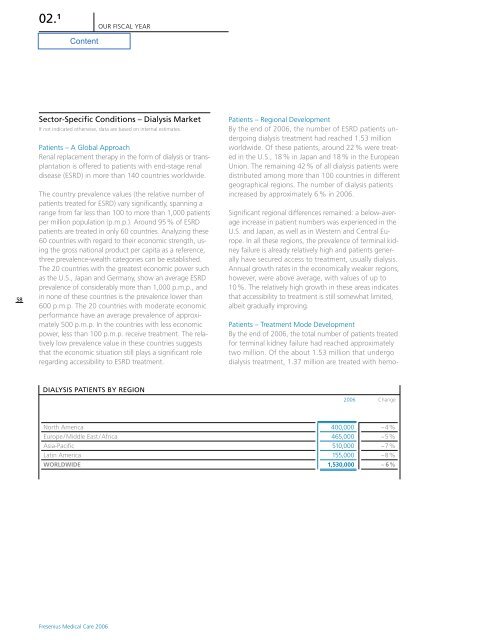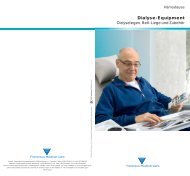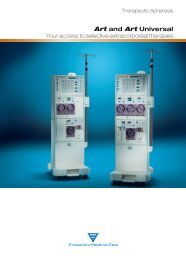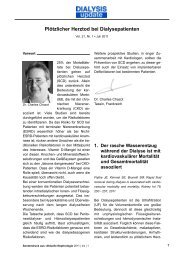Operations and Business Environment - Fresenius Medical Care
Operations and Business Environment - Fresenius Medical Care
Operations and Business Environment - Fresenius Medical Care
Create successful ePaper yourself
Turn your PDF publications into a flip-book with our unique Google optimized e-Paper software.
02. 1 Our Fiscal year<br />
58<br />
Sector-Specific Conditions – Dialysis Market<br />
If not indicated otherwise, data are based on internal estimates.<br />
Patients – A Global Approach<br />
Renal replacement therapy in the form of dialysis or transplantation<br />
is offered to patients with end-stage renal<br />
disease (ESRD) in more than 140 countries worldwide.<br />
The country prevalence values (the relative number of<br />
patients treated for ESRD) vary significantly, spanning a<br />
range from far less than 100 to more than 1,000 patients<br />
per million population (p.m.p.). Around 95 % of ESRD<br />
patients are treated in only 60 countries. Analyzing these<br />
60 countries with regard to their economic strength, using<br />
the gross national product per capita as a reference,<br />
three prevalence-wealth categories can be established.<br />
The 20 countries with the greatest economic power such<br />
as the U.S., Japan <strong>and</strong> Germany, show an average ESRD<br />
prevalence of considerably more than 1,000 p.m.p., <strong>and</strong><br />
in none of these countries is the prevalence lower than<br />
600 p.m.p. The 20 countries with moderate economic<br />
performance have an average prevalence of approximately<br />
500 p.m.p. In the countries with less economic<br />
power, less than 100 p.m.p. receive treatment. The relatively<br />
low prevalence value in these countries suggests<br />
that the economic situation still plays a significant role<br />
regarding accessibility to ESRD treatment.<br />
Patients – Regional Development<br />
By the end of 2006, the number of ESRD patients undergoing<br />
dialysis treatment had reached 1.53 million<br />
worldwide. Of these patients, around 22 % were treated<br />
in the U.S., 18 % in Japan <strong>and</strong> 18 % in the European<br />
Union. The remaining 42 % of all dialysis patients were<br />
distributed among more than 100 countries in different<br />
geographical regions. The number of dialysis patients<br />
increased by approximately 6 % in 2006.<br />
Significant regional differences remained: a below-average<br />
increase in patient numbers was experienced in the<br />
U.S. <strong>and</strong> Japan, as well as in Western <strong>and</strong> Central Europe.<br />
In all these regions, the prevalence of terminal kidney<br />
failure is already relatively high <strong>and</strong> patients generally<br />
have secured access to treatment, usually dialysis.<br />
Annual growth rates in the economically weaker regions,<br />
however, were above average, with values of up to<br />
10 %. The relatively high growth in these areas indicates<br />
that accessibility to treatment is still somewhat limited,<br />
albeit gradually improving.<br />
Patients – Treatment Mode Development<br />
By the end of 2006, the total number of patients treated<br />
for terminal kidney failure had reached approximately<br />
two million. Of the about 1.53 million that undergo<br />
dialysis treatment, 1.37 million are treated with hemo-<br />
Dialysis Patients by Region<br />
2006 Change<br />
North America<br />
Europe / Middle East / Africa<br />
Asia-Pacific<br />
Latin America<br />
Worldwide<br />
400,000<br />
465,000<br />
510,000<br />
155,000<br />
1,530,000<br />
~ 4 %<br />
~ 5 %<br />
~ 7 %<br />
~ 8 %<br />
~ 6 %<br />
<strong>Fresenius</strong> <strong>Medical</strong> <strong>Care</strong> 2006








